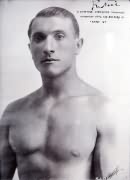
Gymnastics is a sport that includes physical exercises requiring balance, strength, flexibility, agility, coordination, dedication and endurance. The movements involved in gymnastics contribute to the development of the arms, legs, shoulders, back, chest, and abdominal muscle groups. Gymnastics evolved from exercises used by the ancient Greeks that included skills for mounting and dismounting a horse, and from circus performance skills.
Artistic gymnastics is a discipline of gymnastics in which athletes perform short routines on different apparatuses. The sport is governed by the Fédération Internationale de Gymnastique (FIG), which designs the Code of Points and regulates all aspects of elite international competition. Within individual countries, gymnastics is regulated by national federations like British Gymnastics and USA Gymnastics. Artistic gymnastics is a popular spectator sport at many competitions, including the Summer Olympic Games.

Indian clubs, which originated in the Indian subcontinent, are a type of exercise equipment used to present resistance in movement to develop strength and mobility. They consist of juggling club shaped wooden clubs of varying sizes and weights, which are swung in certain patterns as part of a strength exercise program. They can range in weight from a few pounds each to special clubs that can weigh as much as up to 100 pounds. They were used in carefully choreographed routines in which the clubs were swung in unison by a group of exercisers, led by an instructor, similar to 21st-century aerobics or zumba classes. The routines would vary according to the group's ability along with the weights of the clubs being used. When the 19th-century British colonists came across exercising clubs in India, they named them Indian clubs.
The men's club swinging was an artistic gymnastics event held as part of the gymnastics at the 1904 Summer Olympics programme. It was the only time the club swinging event was held, though an "Indian clubs" competition was held at the 1932 Summer Olympics. An unknown number of gymnasts competed, only three are known. The competition was held on Friday, October 28, 1904.
The Artistic Gymnastics World Championships are the world championships for artistic gymnastics governed by the Fédération Internationale de Gymnastique (FIG). The first edition of the championships was held in 1903, exclusively for male gymnasts. Since the tenth edition of the tournament, in 1934, women's events are held together with men's events.
The men's vault event was part of the gymnastics programme at the 1924 Summer Olympics. It was one of nine gymnastics events and it was contested for the third time after 1896 and 1904. The competition was held on Monday, July 21, 1924. Seventy gymnasts from nine nations competed. The eight members of each nation's gymnastics team all competed; Czechoslovakia only had six competitors start the vault. The event was won by Frank Kriz of the United States, the nation's second consecutive victory in the event. Jan Koutný and Bohumil Mořkovský of Czechoslovakia took silver and bronze, respectively, the nation's first medals in the event.
The European Men's Artistic Gymnastics Championships are an annual series of artistic gymnastics championships for male gymnasts from European countries organised by the European Union of Gymnastics.

The men's pommel horse event was part of the gymnastics programme at the 1932 Summer Olympics. It was contested for the fifth time after 1896, 1904, 1924, and 1928. The competition was held on Thursday, August 11, 1932. Ten gymnasts from five nations competed. Each nation was limited to three gymnasts. The event was won by István Pelle of Hungary, the nation's first medal in the pommel horse. Italy also earned its first medal in the event, with Omero Bonoli's silver. Frank Haubold took bronze, the United States' first medal in the event since 1904.
The men's Indian clubs event was part of the gymnastics programme at the 1932 Summer Olympics at Los Angeles. It was contested for the only time at the Olympics. The 1904 Summer Olympics saw a club swinging event. The competition was held on Tuesday, August 9, 1932. Four gymnasts from two nations competed.

The men's artistic individual all-around event was part of the gymnastics programme at the 1932 Summer Olympics. It was the eighth appearance of the event, which was established in 1900. The competition was held from Monday, August 8, 1932, to Wednesday, August 10, 1932. Twenty-four gymnasts from five nations competed. Each nation could enter a team of 5 gymnasts; Hungary sent only 4. The event was won by Romeo Neri of Italy, the nation's first victory in the event since 1920 and fourth overall. István Pelle of Hungary took silver and Heikki Savolainen of Finland earned bronze; it was the first medal in the event for each nation.
The men's team all-around event was part of the gymnastics programme at the 1932 Summer Olympics. It was the seventh appearance of the event, which was established in 1904. The competition was held from Monday, August 8, 1932, to Wednesday, August 10, 1932. Twenty-four gymnasts from five nations competed.

Gymnastics at the 2016 Summer Olympics in Rio de Janeiro was held in three categories: artistic gymnastics, rhythmic gymnastics and trampolining. All gymnastics events were staged at the Arena Olímpica do Rio from 6 to 21 August 2016.

Dipa Karmakar is an Indian artistic gymnast.
The women's vault competition at the 2016 Summer Olympics in Rio de Janeiro, Brazil. The event was held at the HSBC Arena on 14 August.
The women's artistic team all-around event at the 2020 Summer Olympics was held on 25 and 27 July 2021 at the Ariake Gymnastics Centre. There were 12 teams of 4 gymnasts each.
The men's artistic team all-around competition at the 1936 Summer Olympics was held at the Waldbühne on 10 and 11 August. It was the eighth appearance of the event.

The vault is an artistic gymnastics event held at the Summer Olympics. The event was first held for men at the first modern Olympics in 1896. It was held again in 1904, but not in 1900, 1908, 1912, or 1920 when no apparatus events were awarded medals. The vault was one of the components of the men's artistic individual all-around in 1900, however. The men's vault returned as a medal event in 1924 and has been held every Games since. Vault scores were included in the individual all-around for 1924 and 1928, with no separate apparatus final. In 1932, the vault was entirely separate from the all-around. From 1936 to 1956, there were again no separate apparatus finals with the vault scores used in the all-around. The women's vault was added in 1952 and has been held every Games since. Beginning in 1960, there were separate apparatus finals.

The floor is an artistic gymnastics event held at the Summer Olympics. The event was first held for men at the 1932 Olympic Games. For women it was first held in 1952.

The team all-around is an artistic gymnastics event held at the Summer Olympics. The event was first held for men at the third modern Olympics in 1904 but was only contested by teams from the United States. In 1908 and onwards it was contested by multiple different nations. The women's competition was added in 1928, skipped in 1932, and was re-added in 1936. It has been contested at every Olympic Games since.

Rope climbing was an artistic gymnastics event held at the Summer Olympics. It was only held four times: 1896, 1904, 1924, and 1932.









